Market analysis is the process of collecting and analyzing information about your specific market.
It involves speaking to your customers, analyzing competitors, and identifying industry trends.
The result?
You’re able to:
- Make better business decisions
- Save time (and money)
- Create a better experience for your customers
In this article, we’ll go through the exact steps to perform your market analysis. You’ll also learn how to overcome the challenges that come with it.
Step 1: Define Your Purpose
Giving your research a purpose helps you focus on gathering crucial information for your business with fewer distractions.
Think of it like setting off on a road trip.
Without a destination in mind, you’re likely to end up driving aimlessly.
When you’re unclear about why you’re doing a market analysis or what you want to find out, you risk collecting irrelevant information.
And you might miss what really matters for your business.
So, how do you define the purpose of your market analysis?
First, identify the information you want to learn. Then, use this information to set a SMART goal.
Identify Key Focus Areas
Here are some common key focus areas of market analysis:
Market Size
You’ll need to consider the overall size and potential of the market.
Especially when launching new products or developing strategies.
Target Audience
Aim to get as much information about your audience as possible.
Go beyond age, gender, and location. Understand lifestyle, interests, behaviors, and needs.
This will help you craft messages that appeal to your audience and ensure that you offer products or services they need.
For example, subreddits like r/technology or r/smarthome feature interesting discussions about technology.
If you’re running a tech blog, you could use these to understand what people are saying about specific products, brands, or trends.
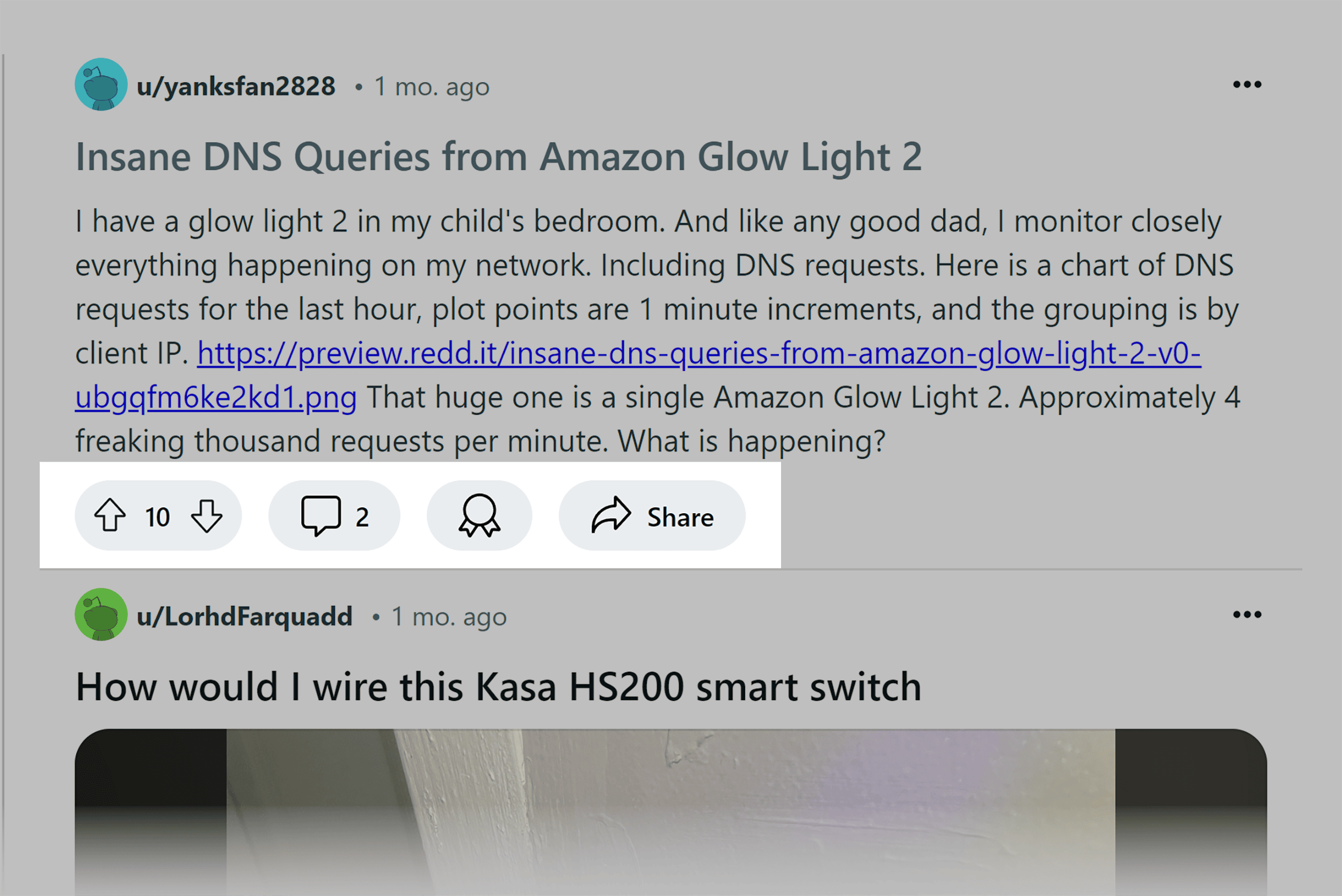
Pay attention to common complaints or frustrations people express about certain gadgets. Consider how you can use these insights to improve your own products and/or messaging.
Competitors
Identify your main competitors and their strengths and weaknesses.
Analyzing competitors will help you craft your own offerings and strategy. Or find gaps in your competitors’ offerings where you can add value to your audience.
Also consider how they acquire new customers. Is it through social media, SEO, email, or ads?
(Jump to Step 4 to find this data.)
This information gives you an insight into which channels you should focus on.
Further reading: Competitor Analysis: Core Principles and How to Conduct One
Pricing Strategy
How you price your products or services will obviously affect your revenue potential.
But it will also affect how your audience perceives your products.
Is there room for another budget-friendly option in your industry? Or would it be better to introduce a high-end version to meet the needs of an underserved portion of the market?
Look at the pricing strategies of your competitors to understand which options could be best for your business.
Set a SMART Goal
Once you know what information you need to find out and analyze, you need to set more specific goals.
The SMART framework helps you set goals that are:
- Specific: Be as precise as possible about what you want to do
- Measurable: Make sure you can track your progress and know when you’ve hit your target
- Achievable: Set goals that are challenging but realistic, given your resources and timeframe
- Relevant: Ensure your goal connects to your broader business objectives
- Time-bound: Set a deadline for your goal to create a sense of urgency and help you stay on track
But what does a SMART goal look like in real life?
Imagine you run a small bakery specializing in gluten-free treats.
You’ve seen a rise in interest in healthy eating. You want to analyze the market potential for expanding your product line.
Vague goal: “I want to understand the gluten-free market better.”
SMART goal: “I want to identify the top three most popular gluten-free baked goods among people aged 25-40 in my city within the next two weeks, so I can adjust my products and attract more people to my shop.”

Do you see the difference?
The SMART goal provides a clear focus for your research and makes it easier to gather the right data.
Helping you draw actionable conclusions that can lead to results for your business.
Now it’s time to actually gather that data.
Step 2: Gather Relevant Data About the Industry
There are various ways to collect relevant market analysis data.
Industry publications and statistics are good sources of information about your industry.
A quick search for terms like “[your industry] publications” and “[your industry] statistics” can serve as a good starting point for finding these sources.

Market research reports provide in-depth analysis of specific markets or industries.
Like this:
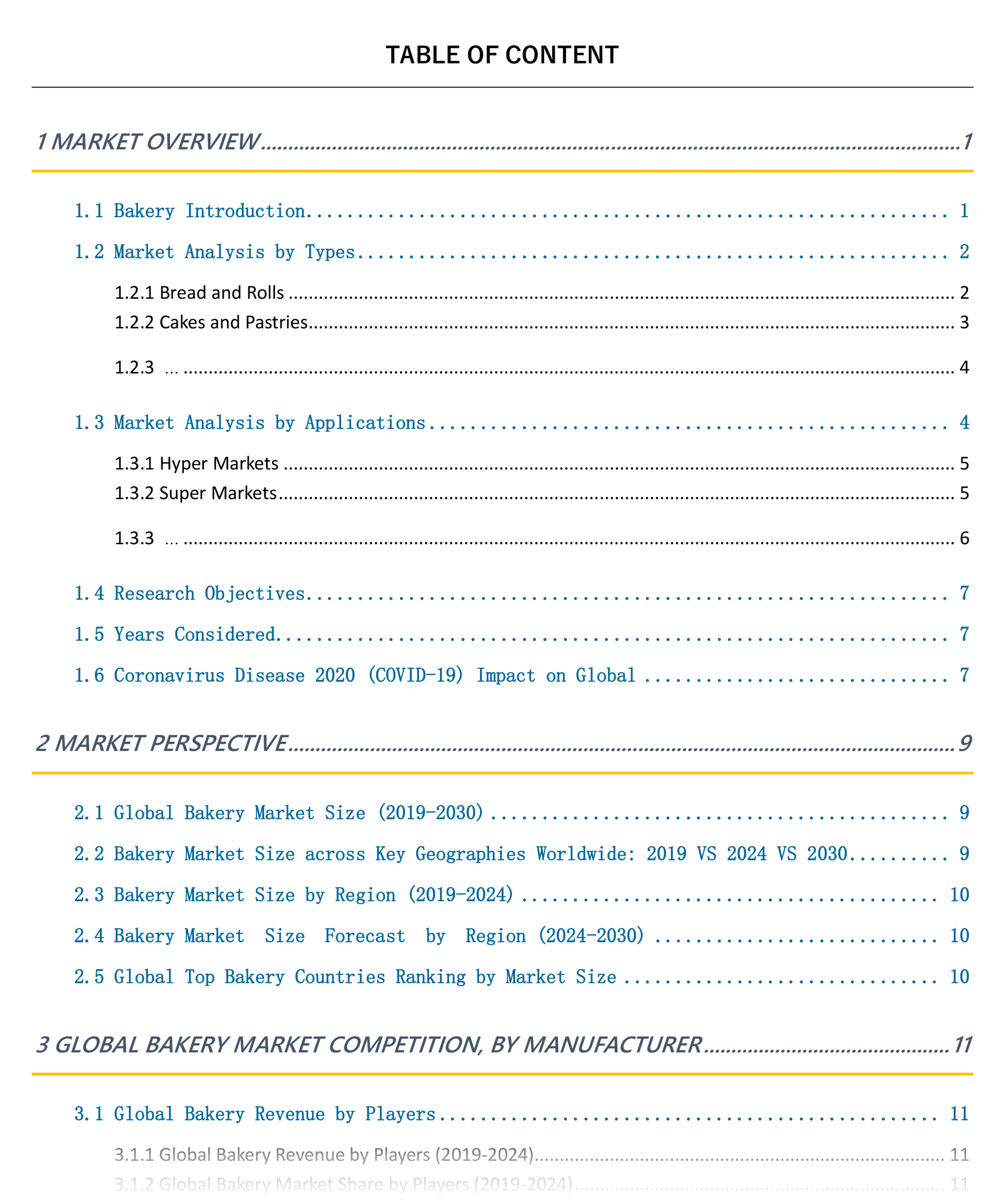
Research firms often publish reports. They offer details about market size, customer behavior, and what competitors are doing.
In other words: valuable information for your market analysis.
You can find these reports on research firm websites, government sites, Google Scholar, or in libraries.
Surveys, interviews, and focus groups let you talk to your potential customers and industry experts.
It’s a great way to get firsthand information and understand people’s motivations.
For example, survey your customers when you launch a new product asking for their feedback:
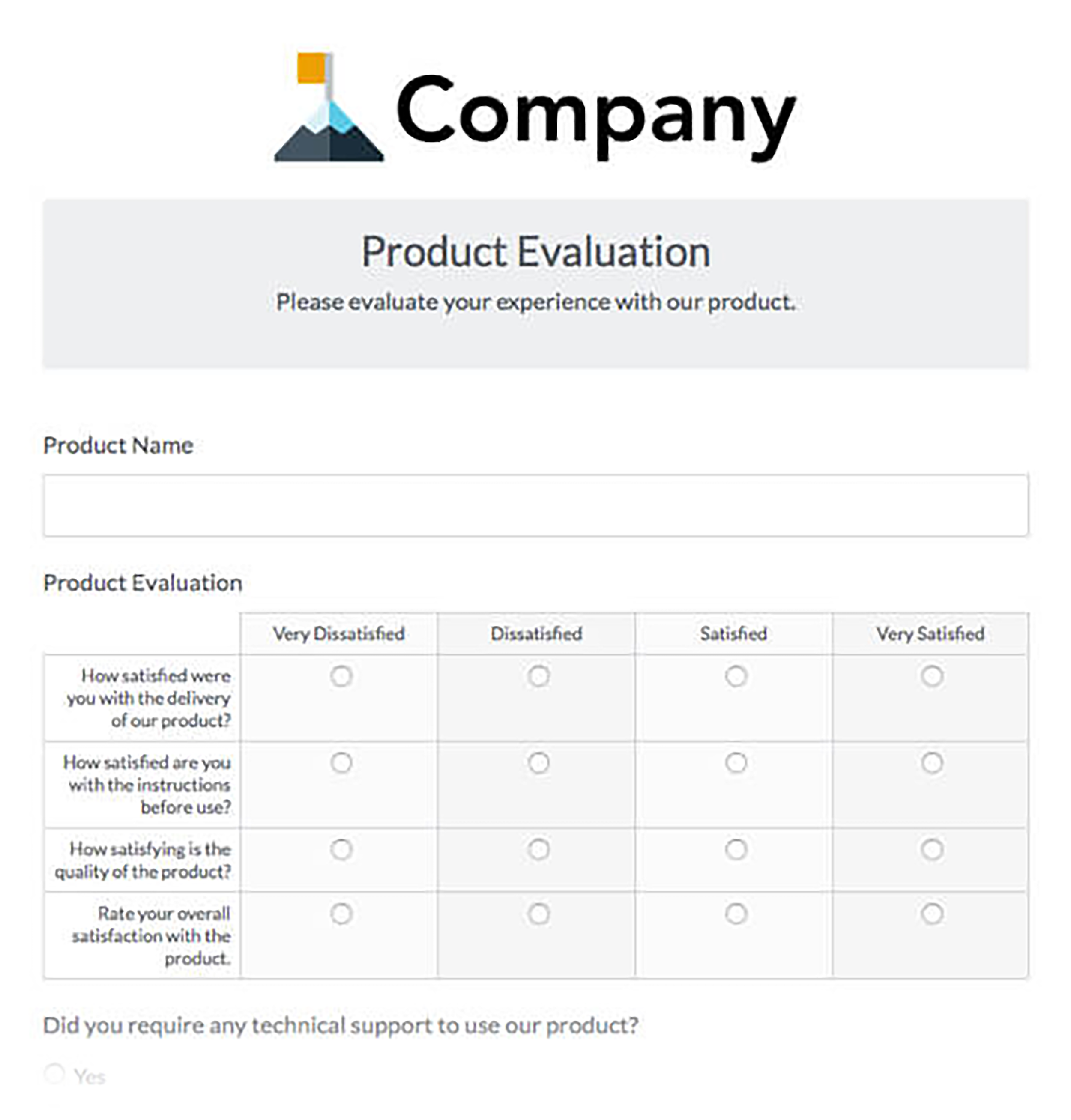
Regardless of your information source, ensure that the data you collect is valid.
Do this by checking how the data was collected and studied. Any reliable report should have a section describing the research methodology.
Similar to this:
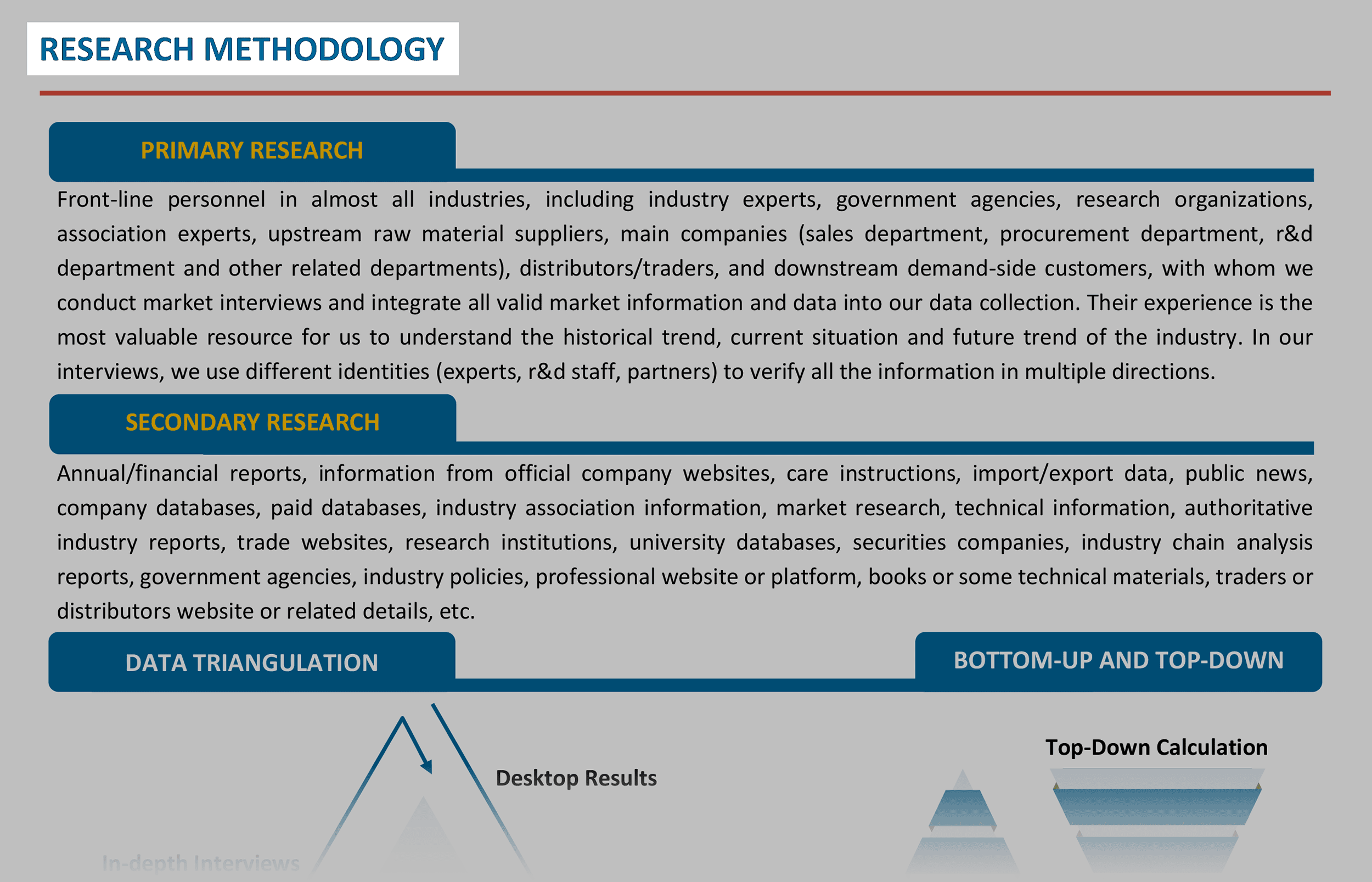
If possible, also compare information from different sources to make sure it’s consistent.
The specific data you’ll need to collect will vary based on your goals.
But you can use the following two areas as a start:
Market Size
Knowing the size of your market gives you an idea of the opportunity you have.
Simply put:
How many potential customers are out there for your product or service?
But how do you find the market size?
Based on your competitors’ data, Semrush’s Market Explorer shows you how many people are interested in your product.
You can enter several competitors into the tool, find competitors to analyze, or analyze an entire category.
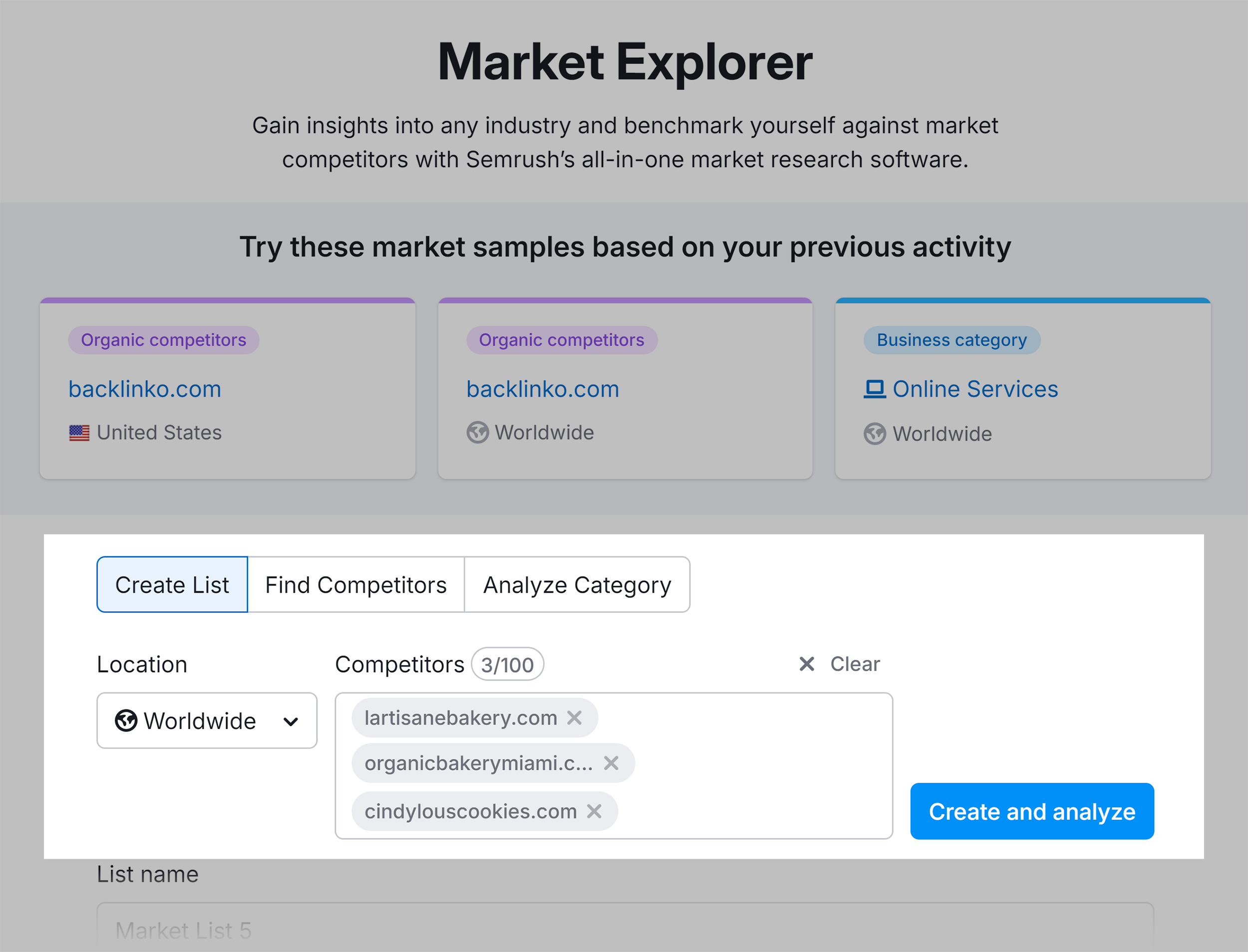
The tool breaks down the market size into two categories:
Total Addressable Market (TAM) and Serviceable Available Market (SAM).
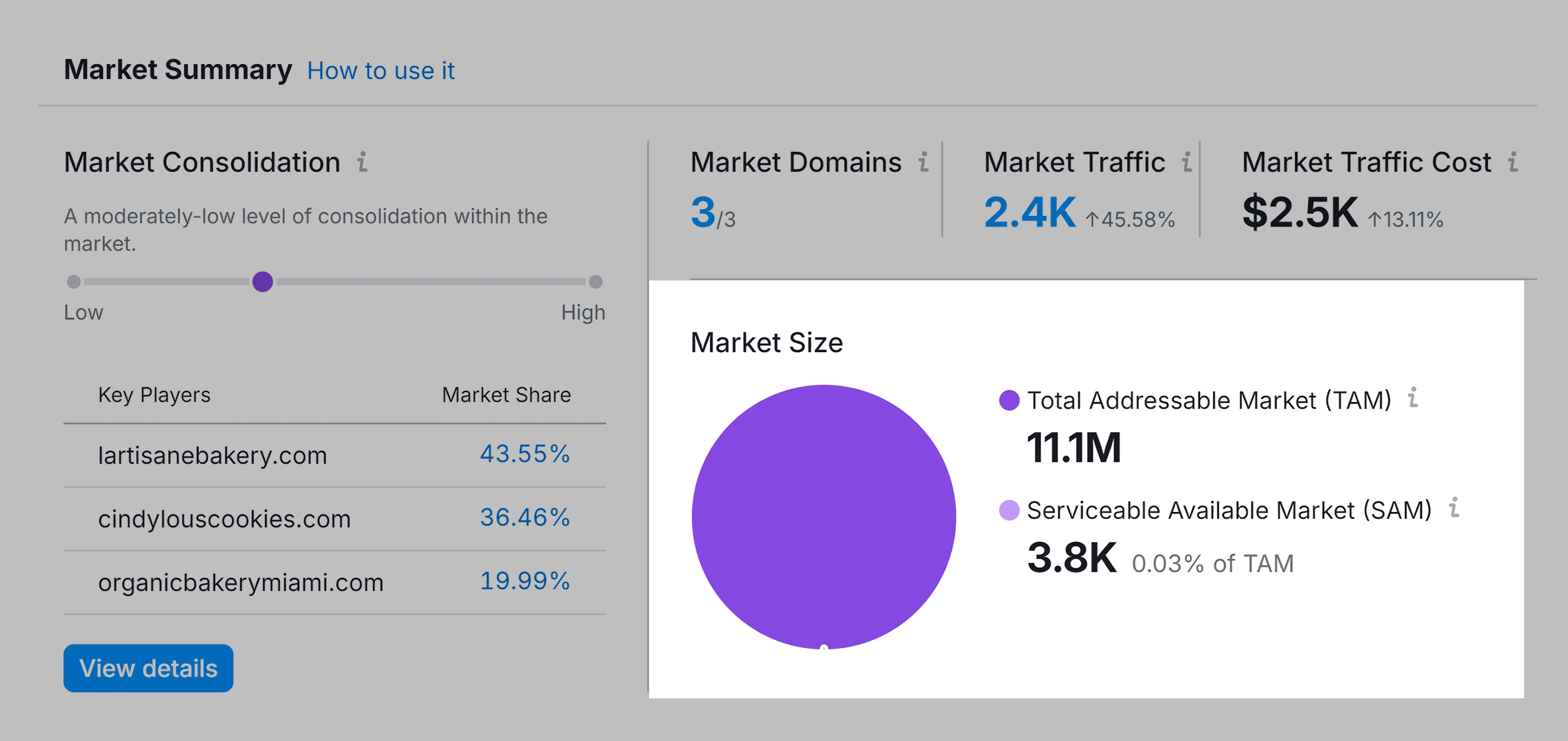
TAM reflects your business’s potential to scale.
It includes all customers. Even those who don’t need or can’t afford the product at the moment. But might need it in the future.
For example, a pregnant woman who will buy diapers in the future.
And SAM tells you how much demand there is for your product at the moment.
This is the number of people who are ready to purchase your product or service.
Industry Trends
Keeping an eye on industry trends can help you identify potential threats and opportunities.
For example, you’ll need to know whether your audience’s interest in your product or service is increasing or decreasing. Or if there are new entrants to your industry that could disrupt your current approach.
You can monitor shifts in your industry or compare demand for specific search terms with Google Trends.
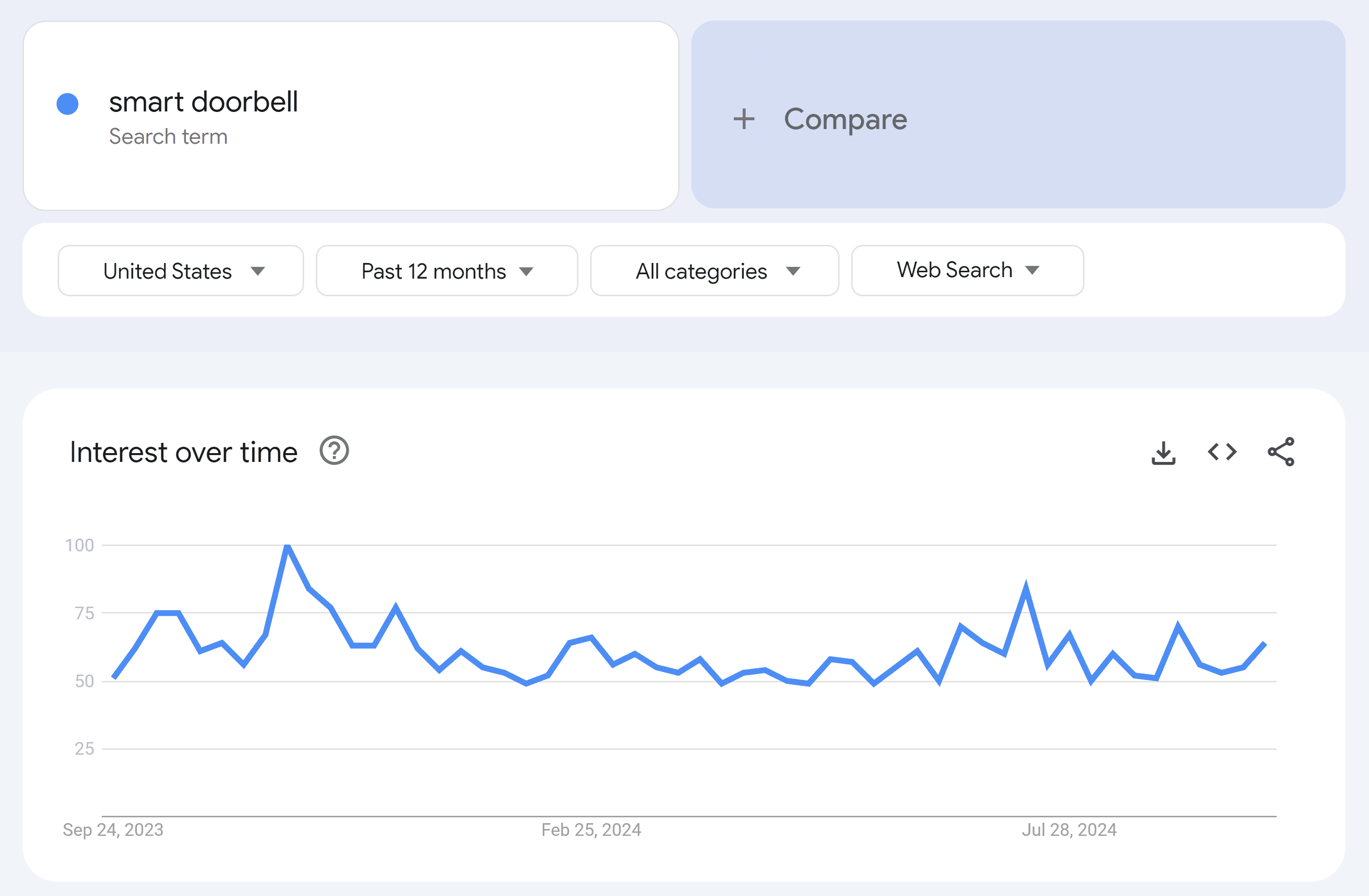
Let’s say you want to decide which product to prioritize as part of your smart home tech website: smart doorbells or smart LED lights.
You can use the tool’s compare function to see how interest in these two search terms has changed over time:

In this case, interest for smart doorbell slightly exceeds the interest for smart LED lights.
But interest for smart LED lights seems to peak around the holiday season each year. This makes sense as that’s when people are decorating their houses for Christmas.
So, it would make sense to prioritize smart doorbells year-round but consider a seasonal push for smart LED lights.
Step 3: Identify Your Target Audience
The better you are at solving people’s problems, the more successful your business will be.
But first, you need to pinpoint WHO these people are.
And we’re not just talking about their age and location.
Dig deeper for an intimate understanding of:
- What specific problems they face in their daily life or within your industry
- What goals or ambitions your product or service could help them achieve
- Which social media platforms they prefer and why
- What types of content they most frequently engage with and share
- How they typically spend their time and what activities they enjoy
- What core values guide their purchasing decisions
With this information, you can craft marketing messages, design product features, and provide customer service interactions that speak directly to them.
This helps build trust and loyalty. Which can lead to sustainable growth for your business.
For example, let’s say you own a local yoga studio. Your ideal student might look something like this:

Understanding your audience deeply like this lets you tailor your marketing and yoga class offerings precisely to their needs.
In this case, you’d be appealing directly to Sarah and other busy moms like her.
This is exactly what Erica, a yoga teacher, does in the Instagram caption below:

She acknowledges the challenges and emotional rollercoaster that motherhood brings.
She also highlights how yoga has supported her through various life stages.
This resonates with moms like Sarah—seeking stress relief, self-care, and community.
You may also have multiple target personas. Especially if you offer various products or services. Or if your offering can benefit more than one group of people.
In our yoga studio example, you might also target:
- Felix, a young professional (25-35) seeking a challenging physical practice to improve their flexibility and mindfulness
- Maria, a retiree (60+) looking for gentle yoga and meditation classes to support her physical and mental well-being
Identifying and understanding these diverse personas can help you prepare a tailored yoga class schedule.
And craft different messages to attract each group of people more effectively to those classes.
But how do you identify your target audience?
And all their needs, characteristics, and preferences?
You can manually observe your existing customers or those of your competitors. Then, note their common traits.
Or, you could gather feedback from your existing audience (like blog readers or social media followers) using a tool like SurveyMonkey.
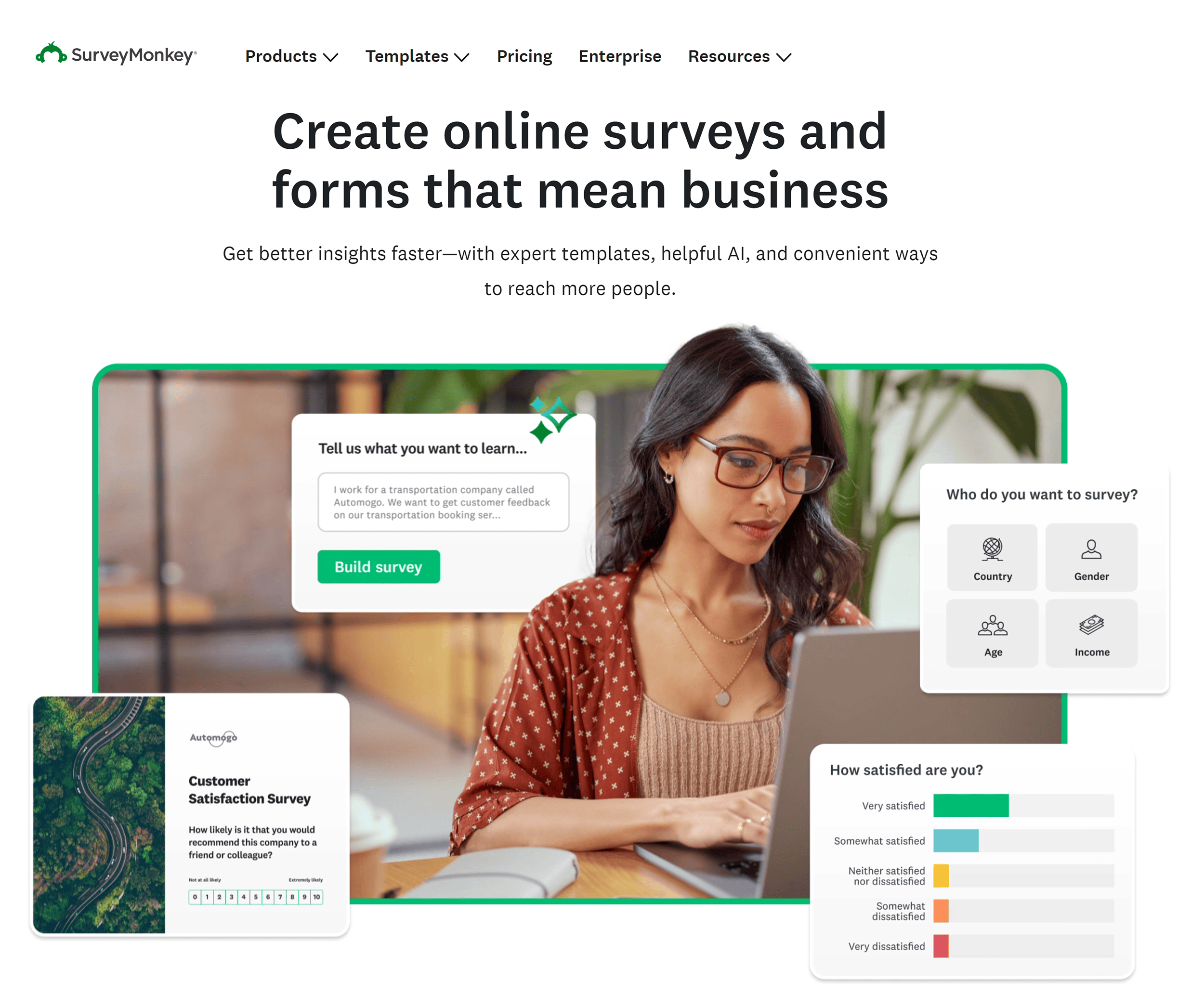
You could ask your readers about their lifestyles and struggles. Or simply what kind of yoga classes they’d like to see in your studio.
Use SurveyMonkey’s templates to build your survey questionnaire. Even build one with AI.
You can also create your own questionnaire from scratch.
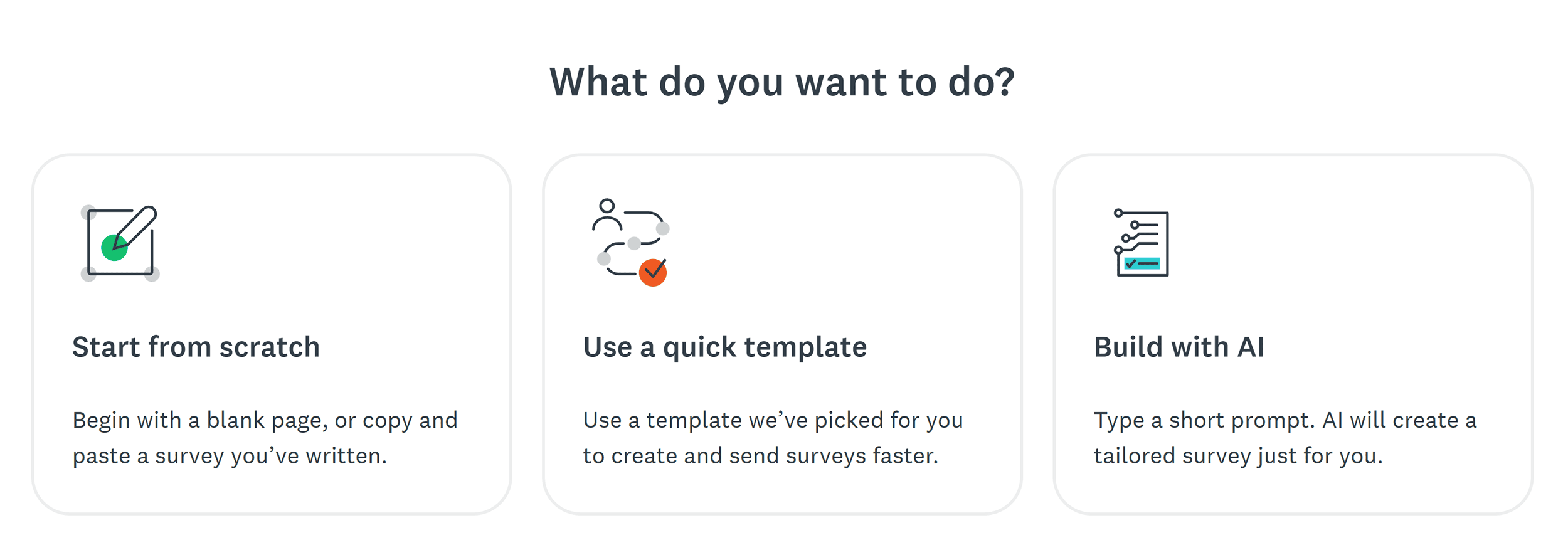
Once you build your questionnaire, send it to your email subscribers, share it on social media, or promote it to your blog audience.
You can also use a marketing tool like Semrush’s One2Target to instantly access data about your target audience.
Here’s how to do it:
In the tool, enter up to five competitors’ websites in the search bar.
(Because if they’re a close competitor, you probably share the same target audience.)
Then click “Analyze.”
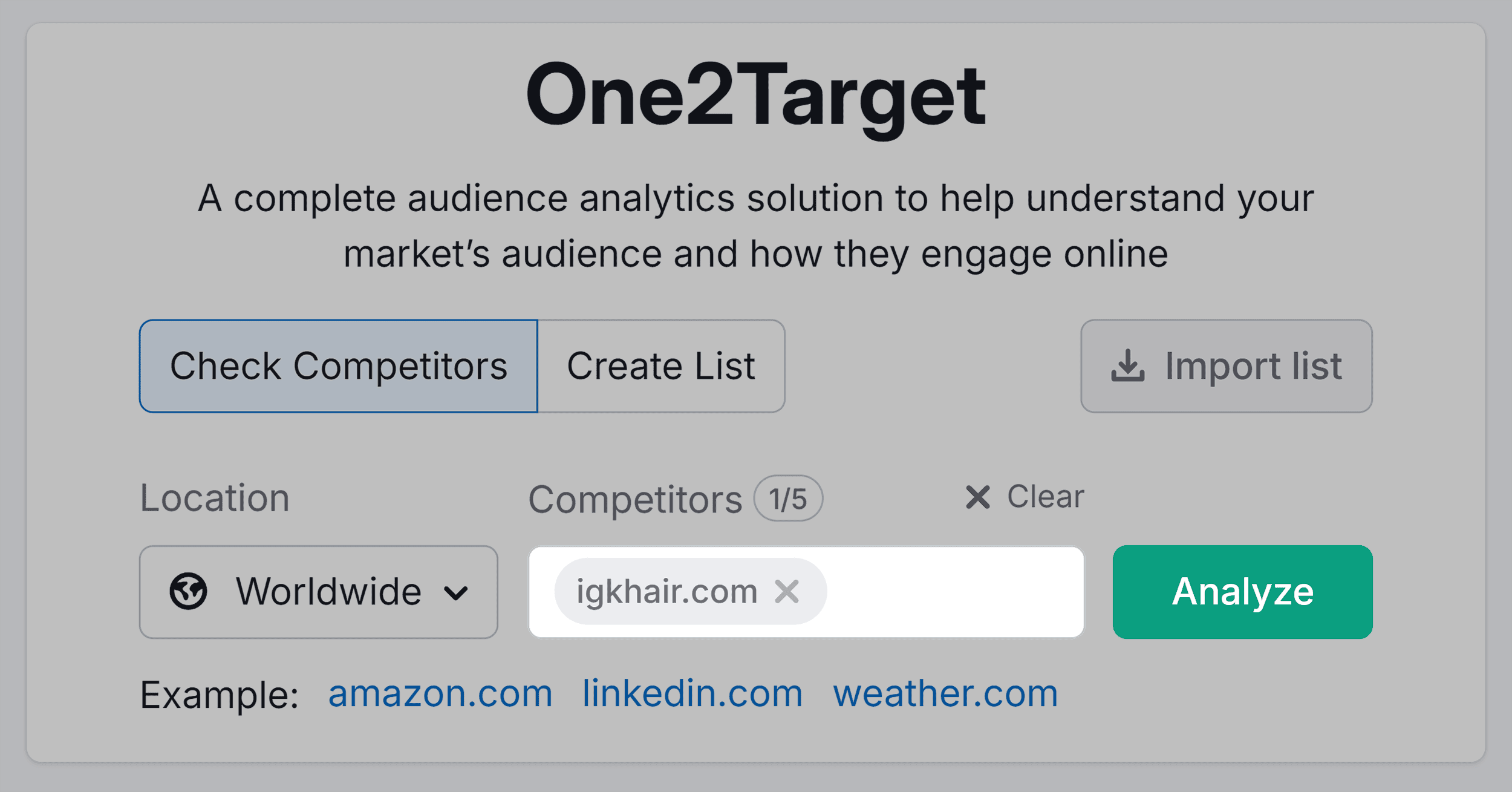
You’ll see details about your audience’s demographics. Including age, sex, and distribution by location.
This helps you understand how to speak your audience’s language.
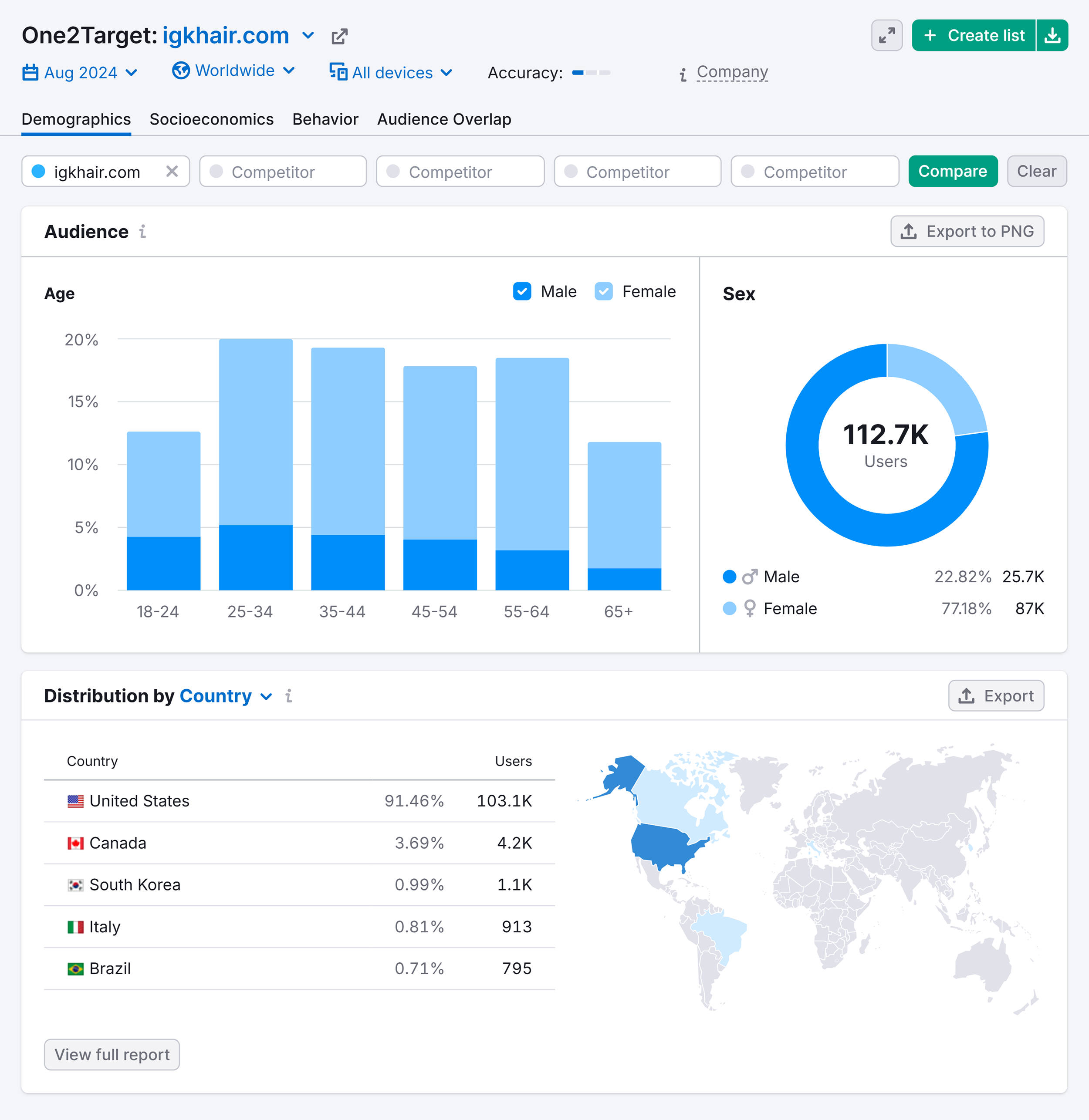
Move to the “Socioeconomics” tab to view your target audience’s household size, income level, employment status, and education level.
Understanding your audience’s socioeconomic situation gives you a sense of their lifestyle and budget.
If they have lower incomes, like in the example below, you may need to emphasize the value and affordability of your product.
Education level can also influence how your audience makes decisions.
A highly educated group might appreciate in-depth technical details. While others might prefer a simpler approach.
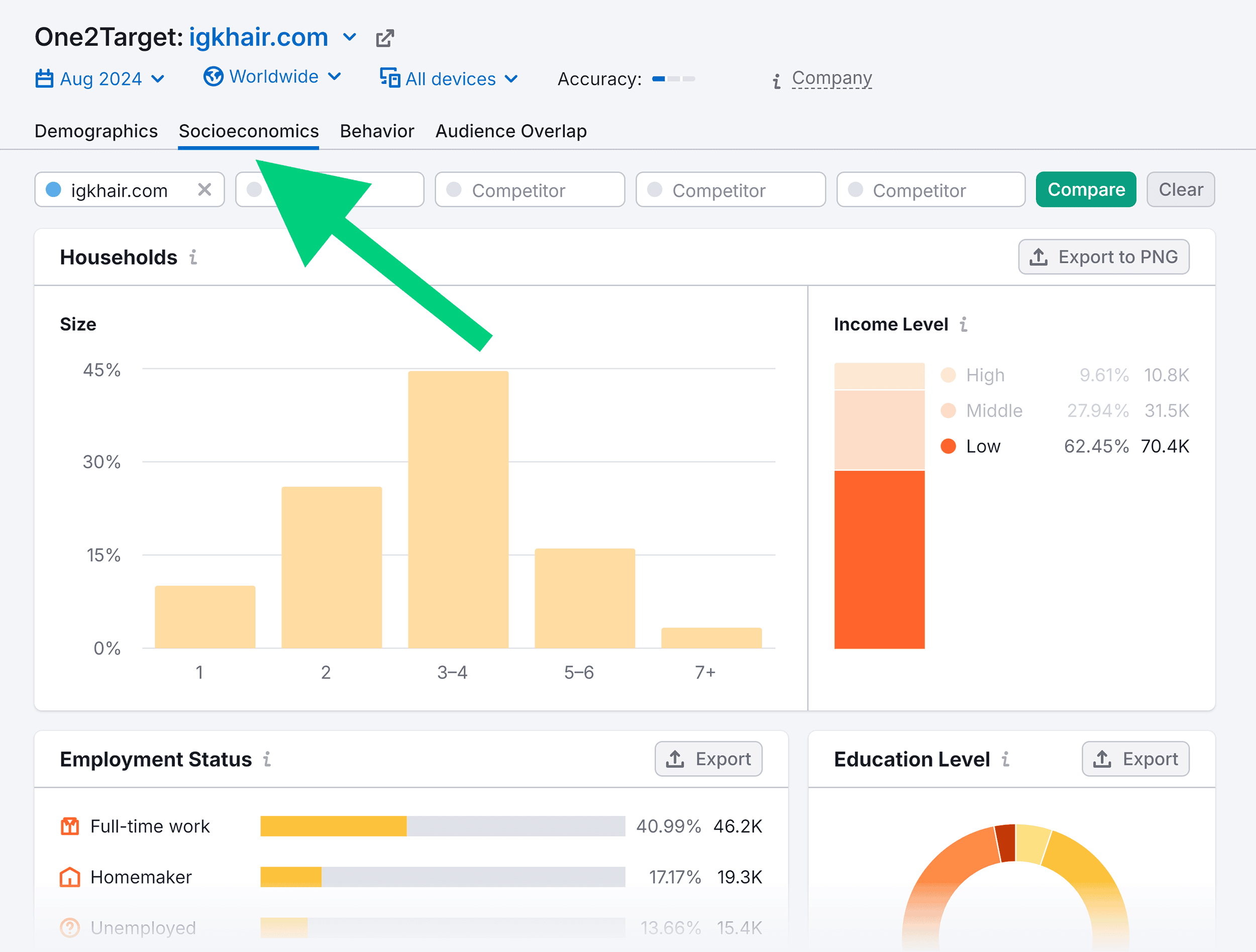
Move to the “Behavior” tab to understand what social media platforms they’re using.
This shows you where your audience hangs out online.
Focus your efforts on the platforms they use most. Instead of overwhelming yourself with publishing content on multiple platforms at once.
This will help you make more efficient use of your marketing budget.
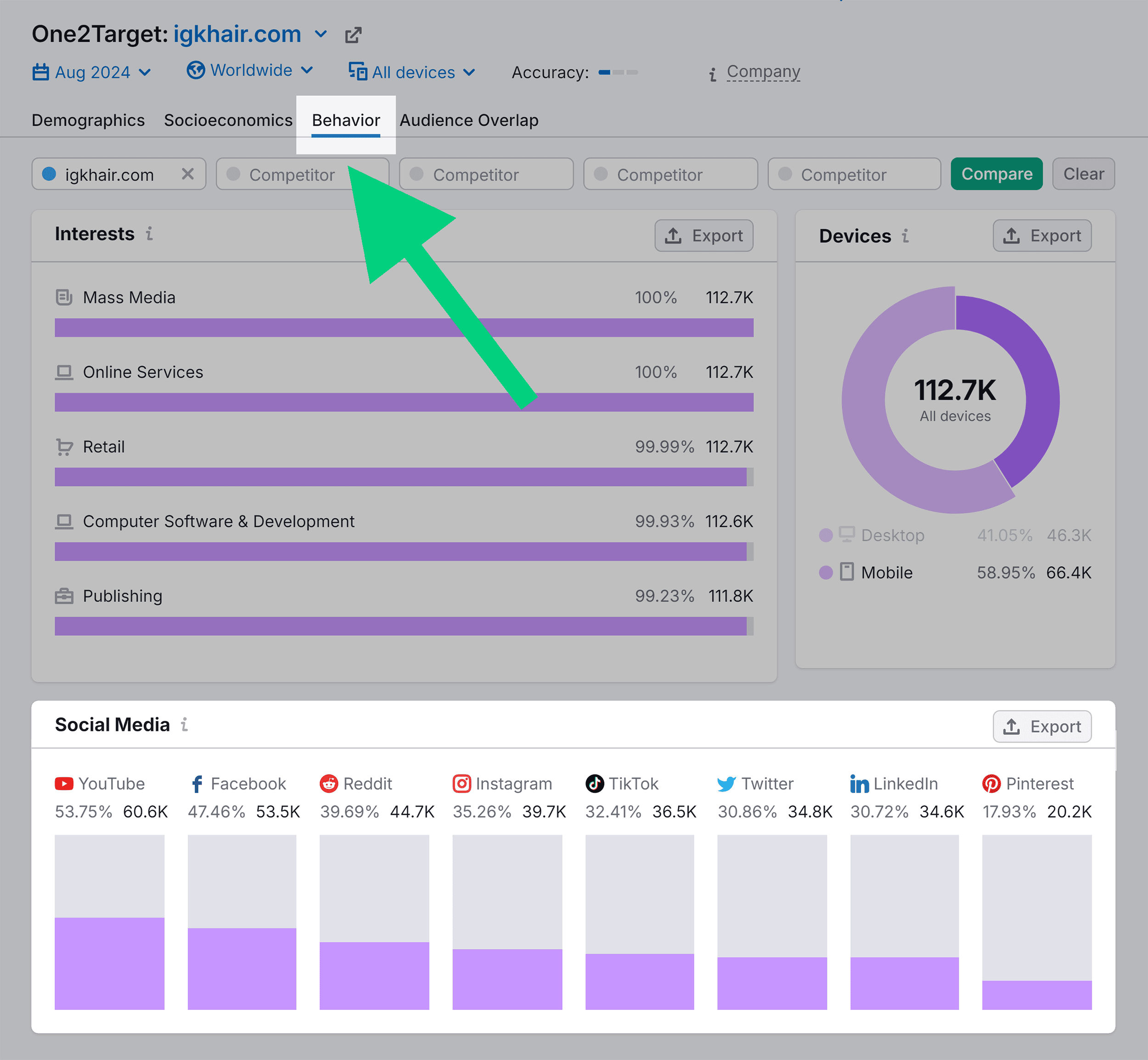
Step 4: Analyze Your Competitors
Analyzing your competitors can reveal their strengths and weaknesses. This can help you find ways to stand out in the market.
But how do you do competitor analysis?
A great starting point is to review their websites and social media profiles and observe what they do.
Then, you can use tools like Semrush’s Traffic Analytics for deeper insights. You can enter up to five competitors in the tool to analyze them in bulk.
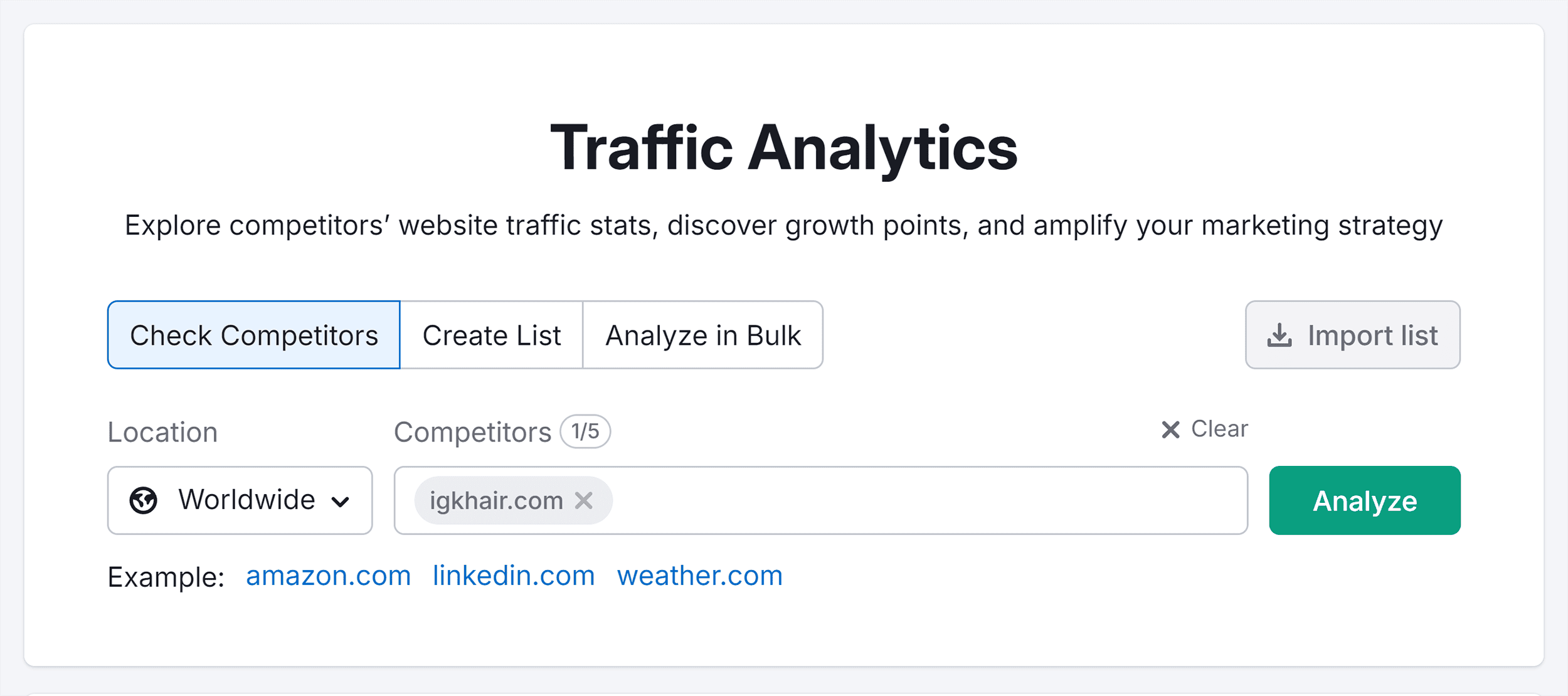
The Traffic Journey tab will reveal which marketing channels send the most visitors to your competitor’s website.
In IGK Hair’s case, we see that their primary traffic source is email. Followed by direct and then organic search.
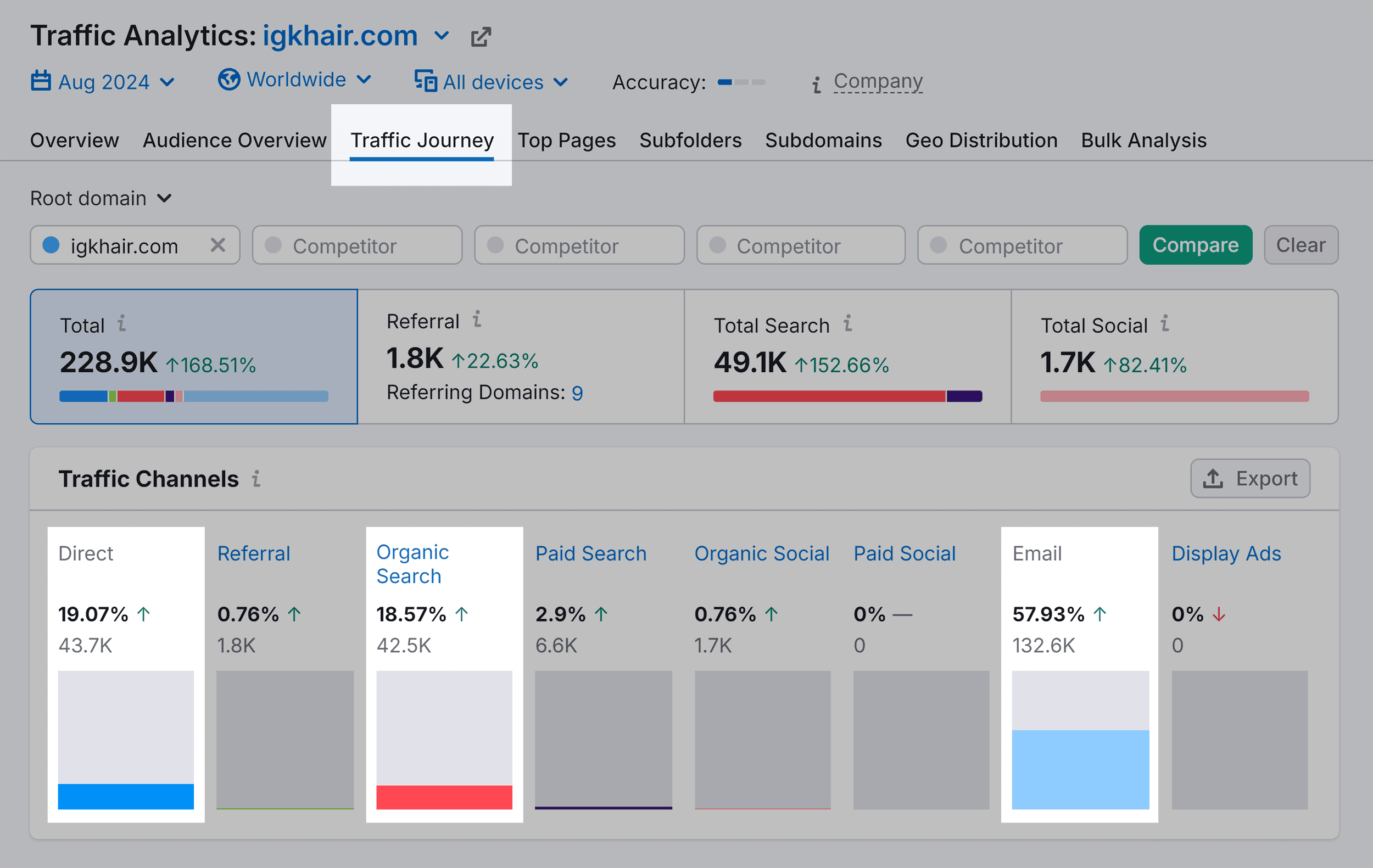
What does this mean?
Almost 58% of traffic comes from email, which suggests that IGK is likely successful in using email marketing to get more repeat website visitors.
And 19% of website visitors directly access IGK Hair’s website. Likely through typing their URL in the browser’s search bar:

And clicking on bookmarks:

Both of these numbers mean that customers know and like IGK Hair. As they keep choosing to come back.
Around 18.6% of traffic comes from organic search—meaning their SEO strategy is working well, too.
The percentage might not sound high. But that’s 42,500 users landing on IGK Hair’s website through Google search every month.
They’re also ranking high for relevant keywords:
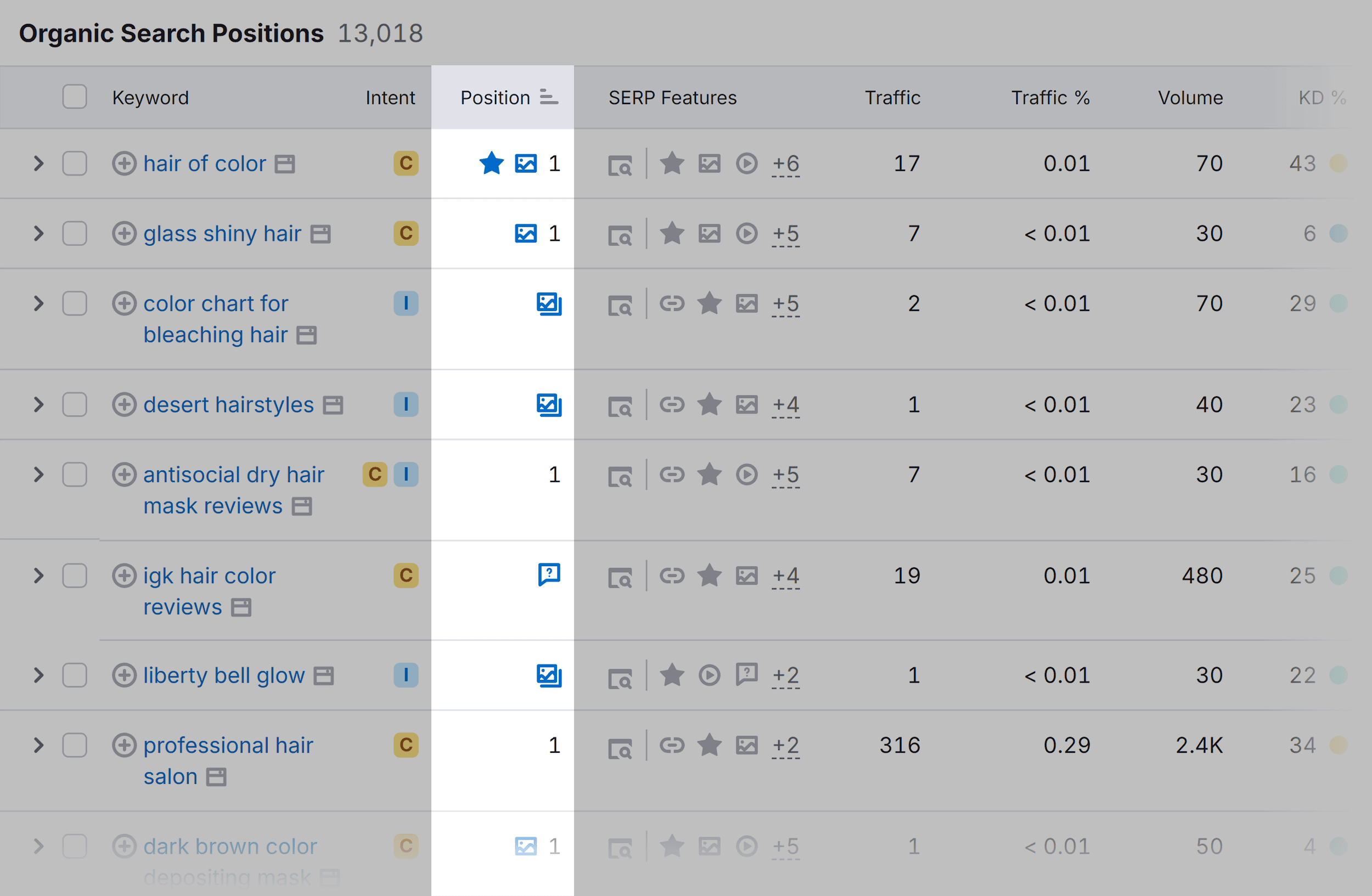
And attracting visitors who are actively searching for tips or services related to hair style or care.
Finally, while not a major source of traffic, IGK Hair is also investing in targeted ads to reach potential customers.
As we can see from the Google Ads Transparency Center, they have a few active ads:
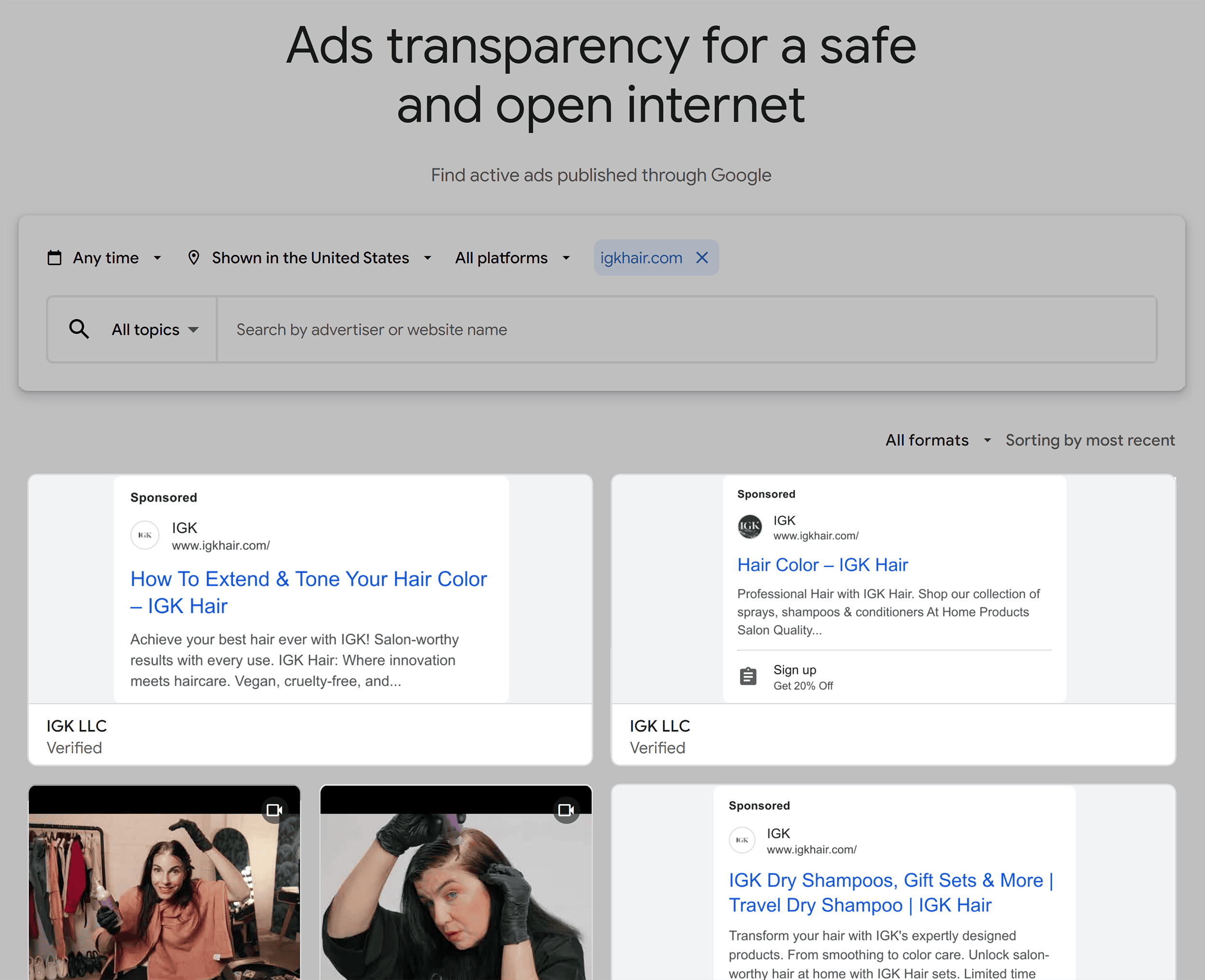
When you know what channels work for your competitors, you can prioritize your marketing efforts accordingly.
Note: A free Semrush account gives you 10 searches in this tool per day. Or you can use this link to access a 14-day trial on a Semrush Pro subscription.
Step 5: Do a SWOT Analysis
A SWOT analysis helps you pinpoint what sets you apart from others. And where you might need to level up.
To do a SWOT analysis, ask yourself the following questions:
- Strengths: What are you good at? What do you do well that sets you apart from competitors?
- Weaknesses: Where could you do better? What are some things you struggle with?
- Opportunities: What trends or changes in the market could benefit you?
- Threats: What external challenges or risks could hurt your business?
Imagine you run a small, local coffee shop.
Here’s what your SWOT analysis might look like:

Step 6: Develop a Marketing Strategy
You’ve gathered lots of useful information from your market analysis.
Now you need to transform those insights into a defined marketing strategy.
This is where you map out your plan of action to reach your target audience, differentiate yourself from competitors, and achieve your business goals.
As Wesley van der Hoop, International SEO Expert and Author of To the Moon, a goal setting book, aptly puts it:
“If you can’t market it, don’t build it”
A comprehensive marketing strategy involves:
- Crafting brand messaging and tone of voice
- Selecting the right marketing channels and tactics to reach your target audience
- Establishing a budget and distributing it across your chosen channels and tactics based on priority
- Tracking your progress and optimizing your strategy
There are clearly a lot of steps here. And each step requires a lot of work on its own.
But you can learn how to do it all with this free Semrush course: How to Create an Effective Marketing Strategy.
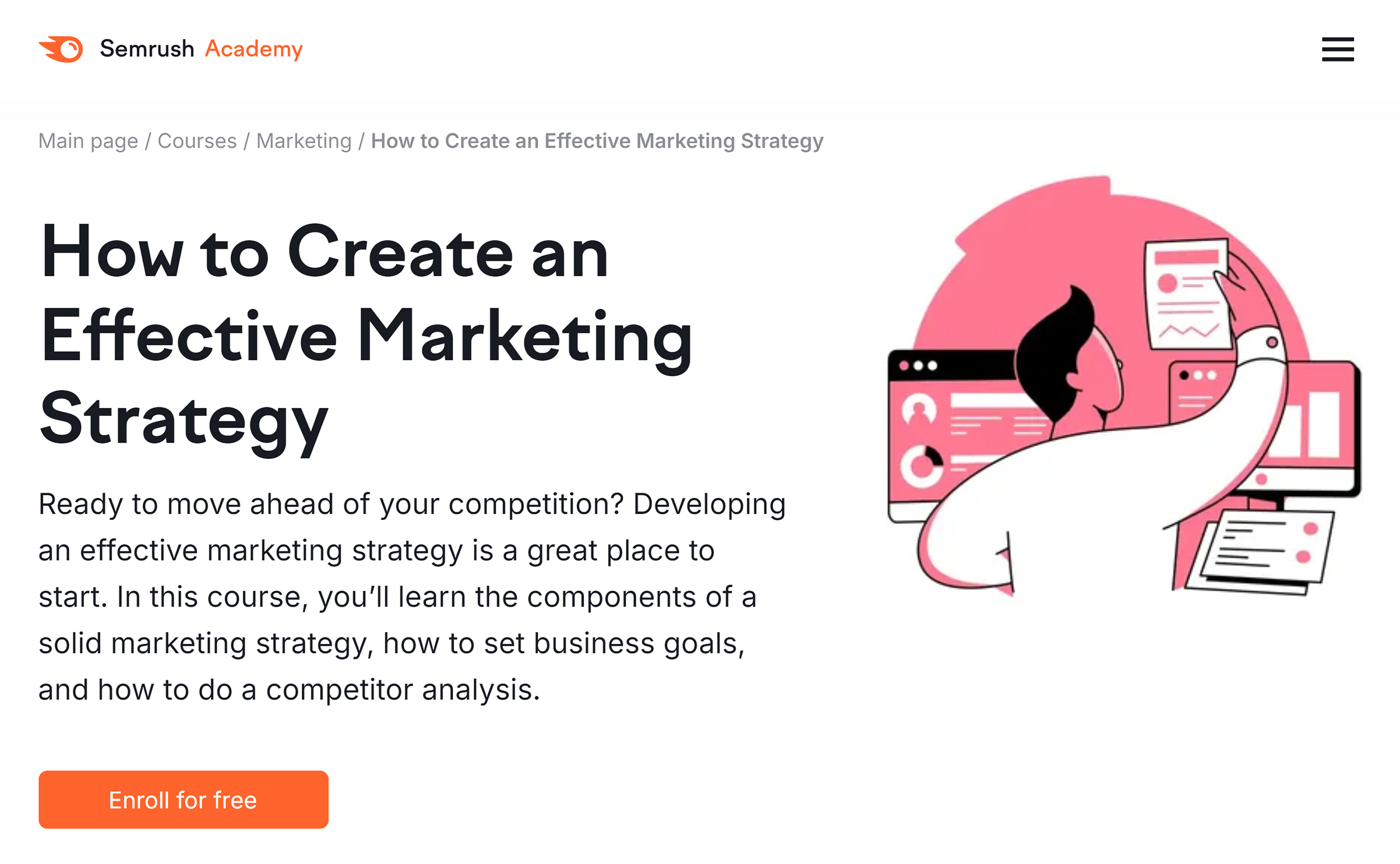
How to Deal with Market Analysis Challenges
Doing market analysis often comes with a number of challenges.
Let’s discuss how you can overcome some of the most common ones:
Data Overload
The amount of data available across the internet can be intimidating.
Social media, market research reports, and industry publications are all great sources of information.
But it can also be challenging to deal with so much data.

Collecting reliable information is a time-consuming task, and it can be draining to try to consume all of the information in your industry.
It might even distract you from finding the data you really need.
What to Do About It
Look back at your market analysis goals, and prioritize the information you need to collect to meet them.
What are the specific questions you need to answer?
Use this question as a filter to weed out irrelevant data. Zero in on the most critical information.
Inaccurate or Biased Data
Unfortunately, not all data is reliable.
Some might be outdated. Some sources might be biased.
Some might even be incomplete or intentionally misleading.
Here’s how to differentiate good data from bad:
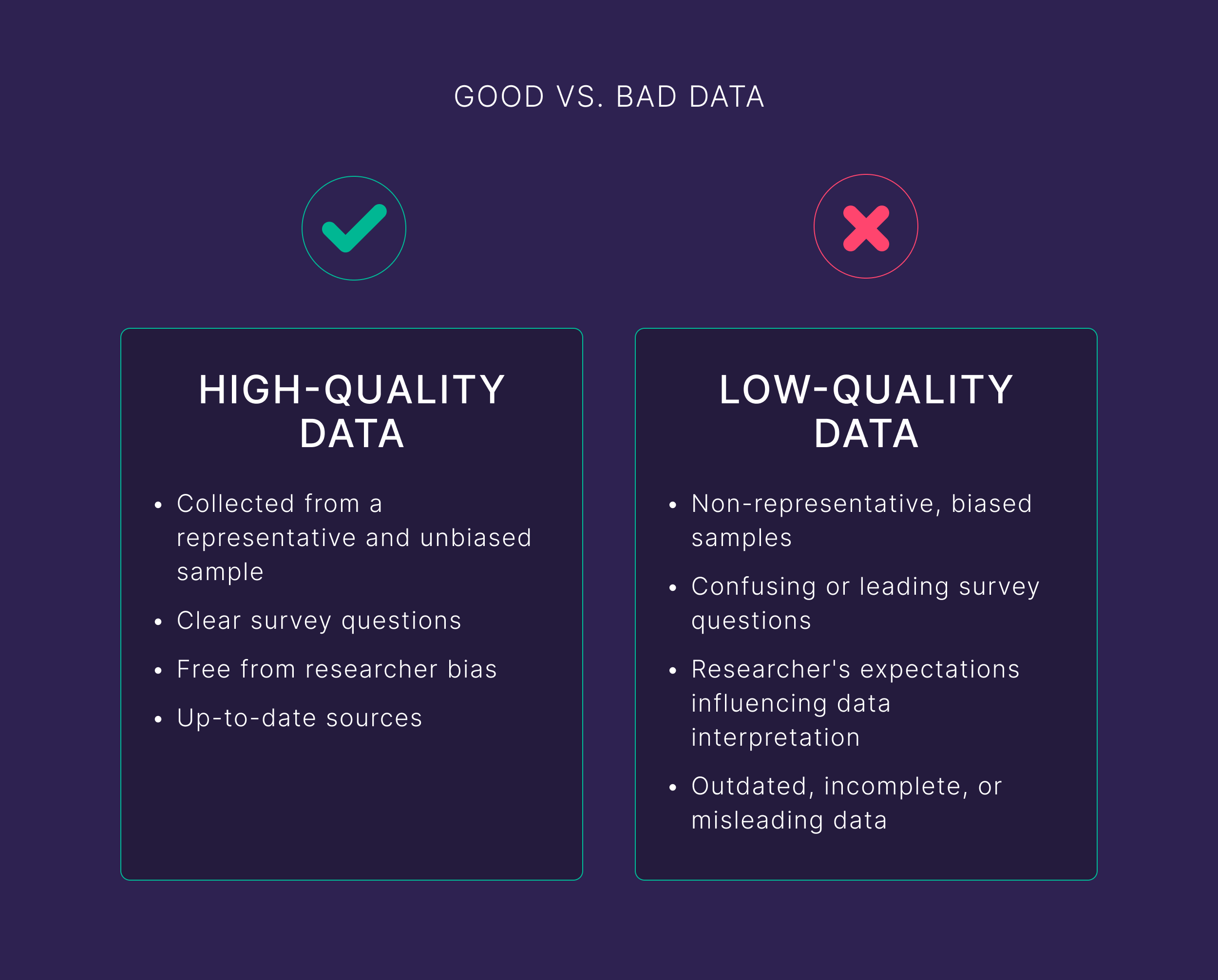
Various factors can influence the accuracy of your data.
For example, sampling bias. Which means the data isn’t collected from a representative sample of your target market.
Confusing questions in surveys can also skew responses. This can lead to inaccurate conclusions.
And researchers can have their own preconceptions or expectations that subconsciously influence how they collect and interpret data.
What to Do About It
There are a few ways you can avoid relying on inaccurate or biased data.
First, look for information from well-established market research firms, industry publications, or government agencies.
Such as:
- Gartner
- Statista
- Nielsen
- Forrester Research
- IDC (International Data Corporation)
- U.S. Bureau of Labor Statistics (BLS)
- U.S. Census Bureau
Avoid data that lacks clear sourcing or comes from biased organizations.
Pro tip: Reliable and reputable sources are transparent about their data collection and analysis methods. So, be careful if a source is vague about how they gathered their data.
Next, check the publishing date of any information you find. Since markets evolve quickly, aim for data no older than three years.
Most reports and statistics will clearly show their publication dates. Like this:

Finally, if possible, gather data from at least two sources and compare the findings.
If you find conflicting information across different sources, dig deeper to find the most reliable data. Or look elsewhere if you can’t confirm its accuracy.
Limited Resources
As a small business or a startup owner, you might have a limited budget. Or not enough people to do the analysis.
Which can make your market research seem daunting. As it can be tough to allocate enough resources to gather the right data.
What to Do About It
While some reports may be costly, there are still free or low-cost resources to use.
So, when you start your research, check the free research reports first.
To filter your initial searches, use a Google search operator.
Let’s say you’re running a local bakery.
Since many free reports are uploaded as PDF files, you’d search something like: bakery industry statistics “PDF”
Like this:

Other reports may mention they’re free. So, search: bakery industry statistics “free”
Like this:
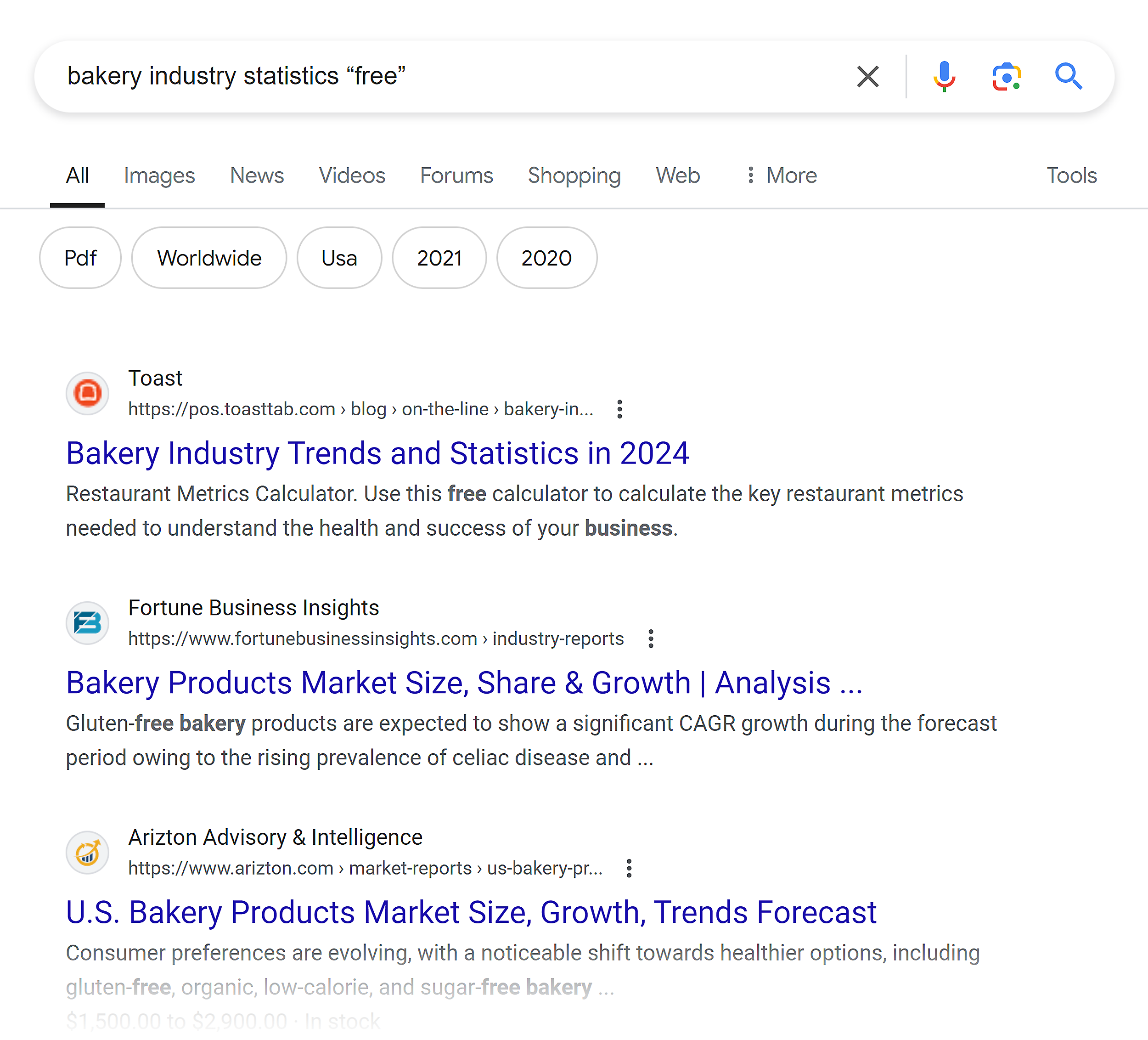
Little Information About Competitors
Small or private companies tend to have a limited online presence. Or less publicly available information.
Which makes it challenging to do competitor analysis.
What to Do About It
Do a Google search with your competitor’s business name and see if they have some media coverage. Or any public information available on a reputable website.
Imagine IGK Hair is one of your competitors again.
Doing a simple Google search leads us to their website and social media profiles.
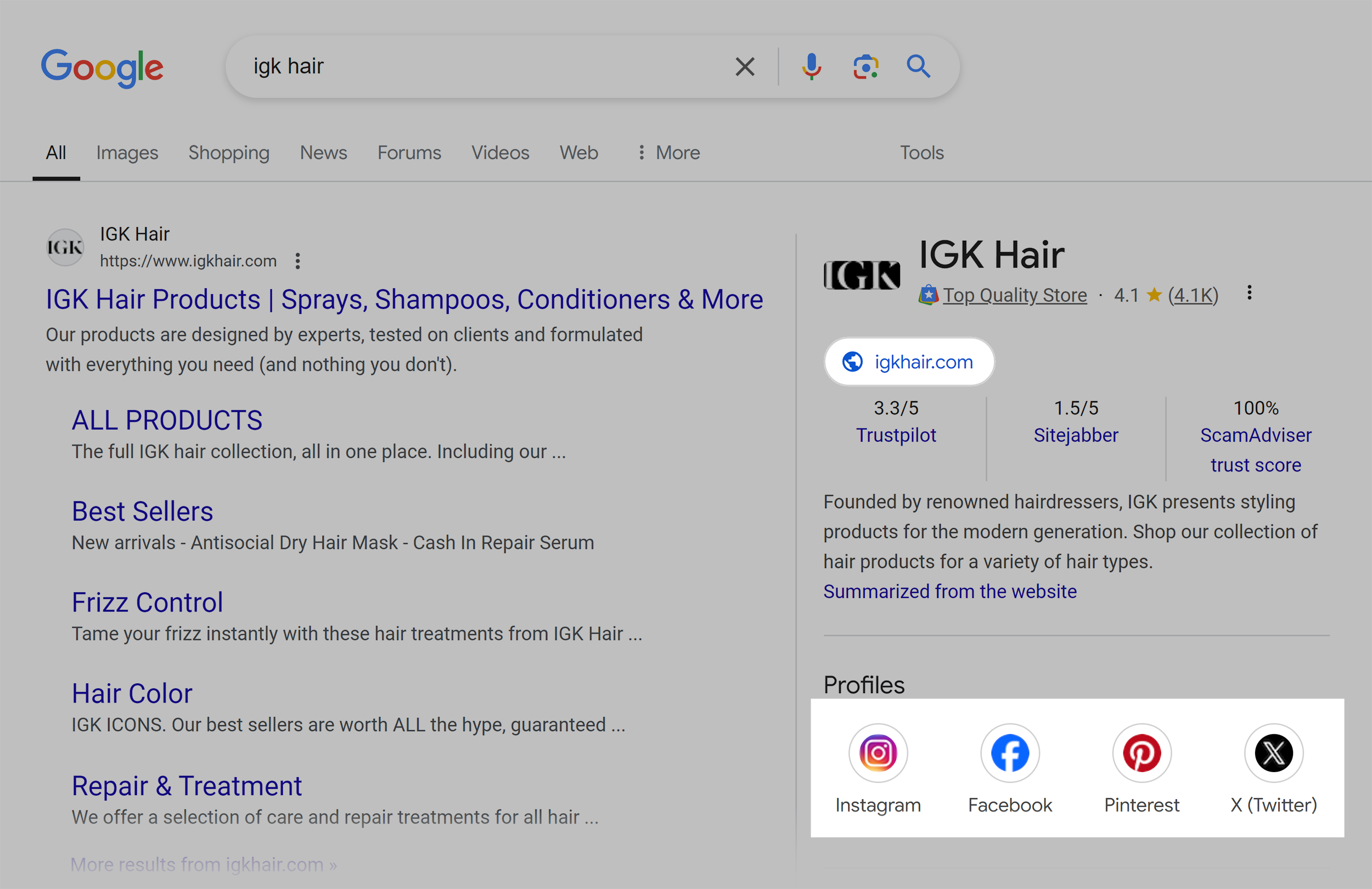
Go through their website, social media channels, and any online reviews.
While you’re at it, read their “About Us” pages, homepage copy, and product offerings.

Notice how they engage with customers through social media.
And what kind of posts they are publishing.

You can also use competitor intelligence tools like Semrush to understand their online strategies.
Like the Traffic Analytics tool’s traffic channels report we discussed earlier:
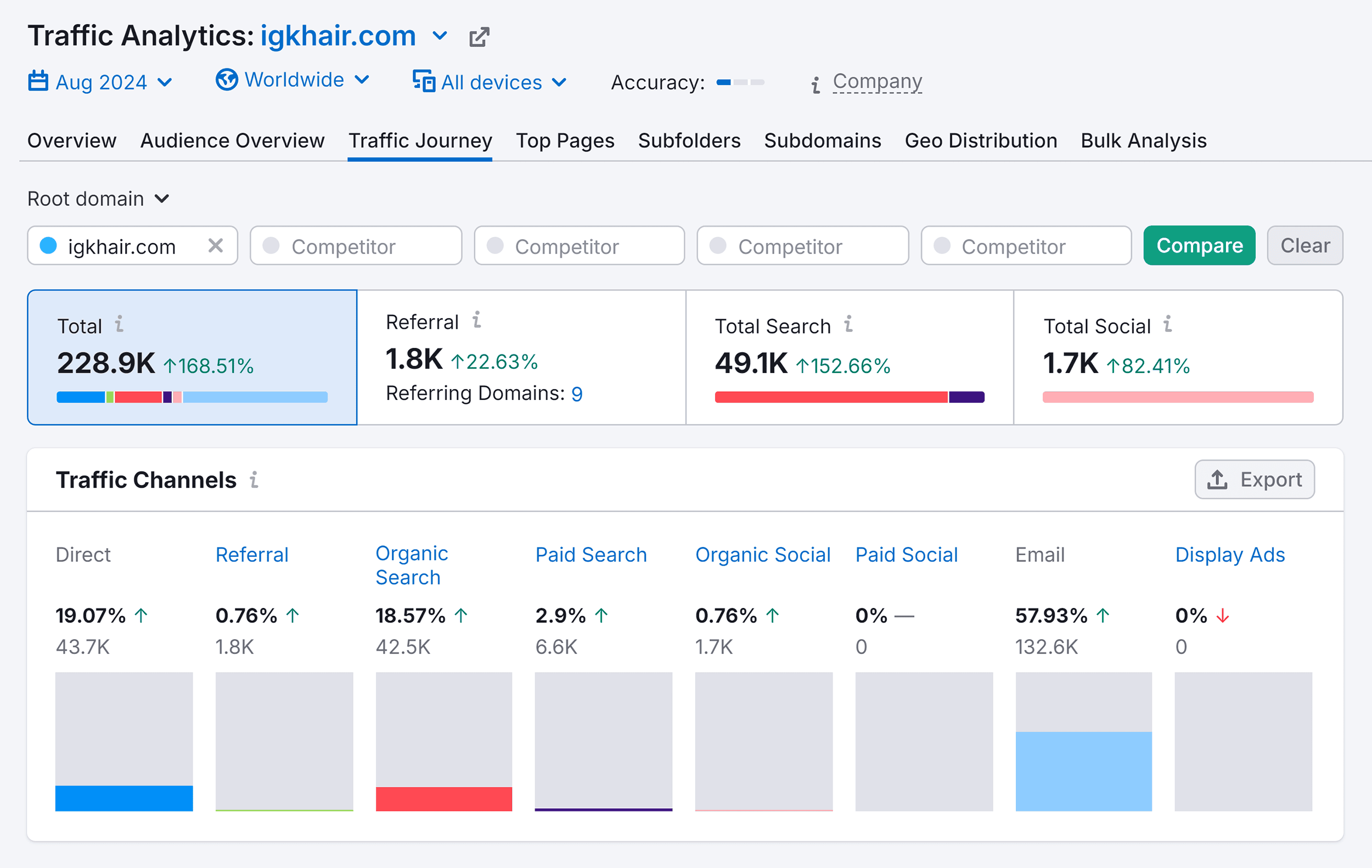
These data sources can help you piece together a picture of their overall online marketing strategy.
Lack of Objectivity
We all have biased opinions. Even if we don’t notice them.
These opinions can influence how we see and understand information.
This is true in market analysis too.
In market analysis, bias can lead to distorted conclusions and wrong decisions.
What to Do About It
Try to separate your personal feelings and assumptions from the data you find.
Acknowledge your biases and ask yourself frequently: is this a fact or my perception? Then, seek additional data to ensure its objectivity. You can do this by comparing data from multiple tools.
Let’s say you want to create content about vegan brownies to attract more vegans to your bakery.
And because you’ve tried some in the past and heard your friends talk about them a lot, you think that “vegan brownies” is clearly going to be a popular search term.
However, a simple Google Trends report shows that it’s not as popular as you thought it would be. And “vegan cookies” is actually more popular:
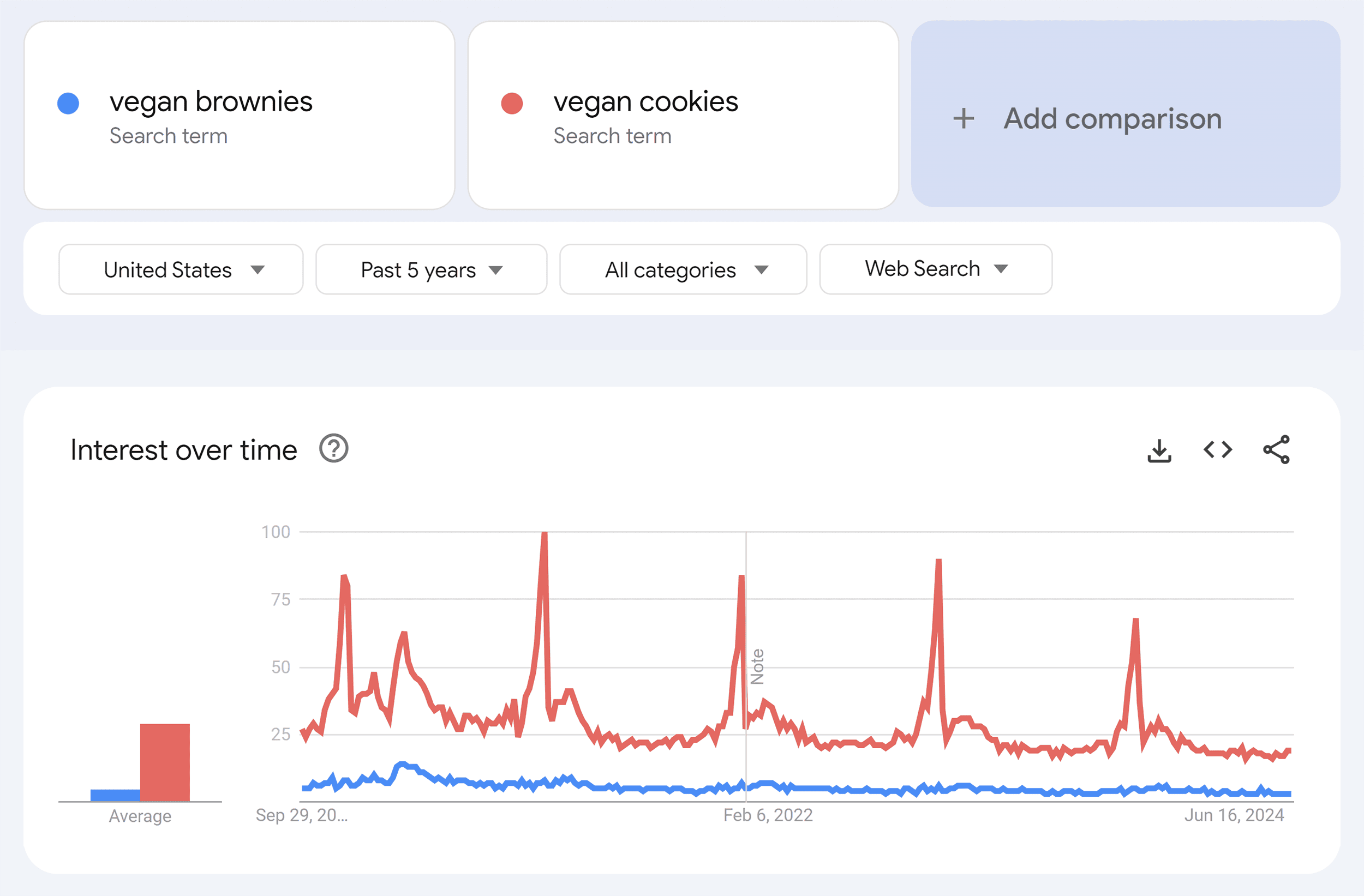
And data from Semrush’s Keyword Overview tool confirms this. As “vegan cookies” has almost doubled the monthly search volume:

By confirming this data, and ignoring your initial biases, you can save time and resources by focusing on the tasks likely to yield the highest returns.
What to Do with Your Market Analysis
It’s true that market analysis can boost your business growth.
But data alone won’t achieve that.
You need to turn those insights into action through your wider marketing strategy.
If you’re ready to turn your market knowledge into tangible results, our small business marketing guide will show you exactly how to do it.
It’s packed with actionable tips and proven strategies to help you reach your target audience and grow your business.
The post How to Do a Market Analysis for Your Business in 6 Steps appeared first on Backlinko.
این خبر را در ایران وب سازان مرجع وب و فناوری دنبال کنیدجهت دانلود و یا توضیحات بیشتر اینجا را کلیک نمایید


